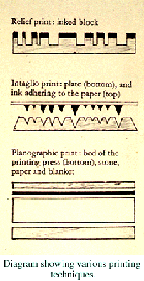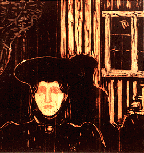

 An
original print is an image on paper or similar material made by one or more of
the processes described here. Each medium has a special, identifiable quality,
but because more than one impression of each image is possible, "original" does
not mean "unique." Prints are multiple originals. The development of printmaking
was connected to the development of movable type and the printing press in the
fifteenth century, although woodblock printing had been done on textiles since
ancient times. If you are interested in
the history of printmaking, click on this link.
An
original print is an image on paper or similar material made by one or more of
the processes described here. Each medium has a special, identifiable quality,
but because more than one impression of each image is possible, "original" does
not mean "unique." Prints are multiple originals. The development of printmaking
was connected to the development of movable type and the printing press in the
fifteenth century, although woodblock printing had been done on textiles since
ancient times. If you are interested in
the history of printmaking, click on this link.
In contemporary printmaking, artists frequently number their prints. The total number of prints made of one image is an edition. The number may appear on the print with the individual print number as a fraction such as 5/25 meaning that this particular print is number 5 of 25 prints made.
Prints in color require two or more blocks, plates, screens or stones, one for each color, printed sequentially on top of each other to produce the final work of art. This process is called registration.
 Prints
can be classified according to the type of surface used to make them. Those
with raised printing surfaces are known as relief prints; woodcuts are
the most common type of relief print. When the printing surface is below the
surface of the plate, the print technique is classified as intaglio.
There are several important intaglio techniques. Planographic and stencil
methods are also used, and print from a surface that is at the same level
as the non-printing surface.
Prints
can be classified according to the type of surface used to make them. Those
with raised printing surfaces are known as relief prints; woodcuts are
the most common type of relief print. When the printing surface is below the
surface of the plate, the print technique is classified as intaglio.
There are several important intaglio techniques. Planographic and stencil
methods are also used, and print from a surface that is at the same level
as the non-printing surface.
 Woodcuts
are made by cutting into the broad face of a plank of wood, usually with a knife
(the linocut is made the same way, except that linoleum is substituted for wood).
In
working
the block, the artist cuts away areas not meant to print. These cut away areas
appear in the finished print as the white parts of the design while the ink adheres
to the raised parts. This link will take you to a Web site that contains an entire
textbook on Woodblock printing by Hiroshi Yoshida
Or also try this site
which offers a set of past to recent examples of European relief printing.
Woodcuts
are made by cutting into the broad face of a plank of wood, usually with a knife
(the linocut is made the same way, except that linoleum is substituted for wood).
In
working
the block, the artist cuts away areas not meant to print. These cut away areas
appear in the finished print as the white parts of the design while the ink adheres
to the raised parts. This link will take you to a Web site that contains an entire
textbook on Woodblock printing by Hiroshi Yoshida
Or also try this site
which offers a set of past to recent examples of European relief printing. Wood engravings are made by engraving a block of end-grain, extremely hard wood. The block, being naturally much harder, enables the artist to engrave (rather than cut) a much finer line than is possible on the softer plank surface used for woodcut. Albrect Durer (15th c.) used this technique in many of his works.
 Lithograph
is a planographic technique in which the artist draws directly
on a flat stone or specially prepared metal plate (usually with a greasy crayon).
The stone is dampened with water, then inked. The ink clings to the greasy crayon
marks, but not to the dampened areas. When a piece of paper is pressed against
the stone, the ink on the greasy parts is transferred to it.
Toulouse-Lautrec and Picasso (left) are among the artists shown who used
this technique. For additional information about lithographs, go to
this site on litho technique .
Lithograph
is a planographic technique in which the artist draws directly
on a flat stone or specially prepared metal plate (usually with a greasy crayon).
The stone is dampened with water, then inked. The ink clings to the greasy crayon
marks, but not to the dampened areas. When a piece of paper is pressed against
the stone, the ink on the greasy parts is transferred to it.
Toulouse-Lautrec and Picasso (left) are among the artists shown who used
this technique. For additional information about lithographs, go to
this site on litho technique .
 Silk
screen is a type of stencil. This technique first came
into use in the early 20th century. The artist prepares a tightly stretched screen,
usually of silk, and blocks out areas not to be printed by filling up the mesh
of the screen with a varnish-like substance (or any number of other materials
which would block up the pores of the fabric). Paper is placed under the screen
and ink forced through the still-open mesh onto the paper. This technique is also
widely used on textiles, including the ever-popular T-shirt.
Robert Rauschenberg and
Andy Warhol are examples of artists that used silkscreen.
Silk
screen is a type of stencil. This technique first came
into use in the early 20th century. The artist prepares a tightly stretched screen,
usually of silk, and blocks out areas not to be printed by filling up the mesh
of the screen with a varnish-like substance (or any number of other materials
which would block up the pores of the fabric). Paper is placed under the screen
and ink forced through the still-open mesh onto the paper. This technique is also
widely used on textiles, including the ever-popular T-shirt.
Robert Rauschenberg and
Andy Warhol are examples of artists that used silkscreen.
| Process | Relief | Intaglio | Planographic | Stencil | Common Name: | Woodcut, linocut, embossing | Engraving, drypoint, mezzotint, etching, aquatint | Lithograph | Serigraph (silkscreen) | What Area Prints: | Prints what is left of the original surface | Prints what is below the surface of the plate | Prints what is drawn on the surface | Prints open areas of the stencil | Type of Press: | Manual pressure or letter press | Etching press (clothes-wringer type) | Lith Press (sliding, scraping pressure) | Original Serigraphs are usually hand screened | Materials: | Wood or linoleum block or other film material | Copper, zinc, plastics, etc. | Limestone, zinc, aluminum plates, etc. | Silk, nylon, etc. | Basic Tools: | Knife, gouge, burin, etc. | Etching needles, burins, acids | Litho crayon, tusche, litho rubbing ink, etc. | Squeegee, screen, screen blocker (liquid, photosensitive block or film) |
|---|

|